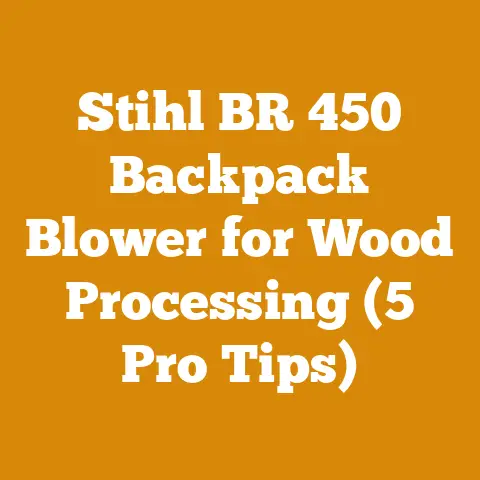Mobile Home Oil Burner Tips (5 Must-Know Woodfire Hacks)
Introduction: Mobile Home Oil Burners and the Woodfire Advantage
As someone who has spent years felling trees, processing timber, and mastering the art of firewood preparation, I understand the challenges of heating a home efficiently, especially a mobile home. Mobile homes, while offering affordability and flexibility, can be notorious for their heating systems. One common system is the oil burner. However, oil prices fluctuate, and the environmental impact is a growing concern. That’s where the woodfire advantage comes in.
Over the years, I’ve seen firsthand how strategically using a wood-burning stove or fireplace can significantly reduce reliance on oil, saving money and providing a sustainable heating alternative. But it’s not as simple as throwing any old log into the fire. It requires understanding wood types, proper seasoning, efficient burning techniques, and crucial safety measures. I’ve learned these lessons the hard way, through trial and error, and I’m here to share five must-know woodfire hacks to help you optimize your mobile home’s heating system. Let’s dive in.
Understanding Your Mobile Home Oil Burner and Supplemental Wood Heat
Before jumping into woodfire hacks, it’s crucial to understand how your oil burner works and how wood heat can supplement it effectively. Oil burners heat air, which is then distributed through ductwork. Wood stoves provide radiant heat, which warms objects and people directly. This difference is key to strategically using wood heat.
Assessing Your Oil Burner’s Efficiency
The first step is understanding your oil burner’s efficiency. Newer models have higher Annual Fuel Utilization Efficiency (AFUE) ratings, meaning they waste less fuel. Check your burner’s documentation or look for a sticker on the unit itself. An AFUE of 80% or higher is considered good. If your burner is older and less efficient (below 70%), supplementing with wood heat becomes even more beneficial.
Integrating Wood Heat for Maximum Impact
The goal isn’t to completely replace your oil burner (unless you have a specific wood-burning furnace designed for that). Instead, aim to reduce its workload, especially during peak heating hours. A well-placed wood stove can heat the main living area, allowing you to lower the thermostat for the oil burner, saving fuel.
Choosing the Right Wood Stove or Fireplace Insert
The type of wood-burning appliance is critical. A traditional open fireplace is very inefficient, losing much heat up the chimney. A modern wood stove or fireplace insert with a closed combustion chamber and air controls is far more efficient, often reaching 70-80% efficiency. Look for models certified by the EPA (Environmental Protection Agency) for clean burning.
- Wood Stove: Freestanding units that radiate heat in all directions. They are ideal for heating a large open space.
- Fireplace Insert: Designed to fit into an existing fireplace opening, significantly improving its efficiency.
- Size Matters: Choose a stove or insert sized appropriately for your mobile home’s square footage. An oversized unit will overheat the space, while an undersized unit won’t provide enough heat.
Takeaway: Understand your oil burner’s efficiency and choose a wood-burning appliance that complements it, not competes with it. Consider the size of your mobile home when selecting a wood stove or fireplace insert.
Hack #1: The Wood Selection Masterclass – Species, Seasoning, and Storage
The heart of any successful woodfire heating system lies in the wood itself. Choosing the right species, properly seasoning it, and storing it correctly are fundamental. I’ve seen countless people struggle with smoky fires, low heat output, and creosote buildup simply because they neglected these crucial steps.
Understanding Wood Species and BTU Content
Different wood species have different energy densities, measured in British Thermal Units (BTUs) per cord. Hardwoods like oak, maple, and ash contain significantly more BTUs than softwoods like pine, fir, and spruce. This means you’ll get more heat from a given volume of hardwood, and it will burn longer.
Here’s a general comparison:
- High BTU (20+ million BTU/cord): Oak, Maple, Hickory, Beech, Ash
- Medium BTU (15-20 million BTU/cord): Birch, Cherry, Elm
- Low BTU (Less than 15 million BTU/cord): Pine, Fir, Spruce, Poplar
While softwoods are easier to ignite, they burn quickly and produce more creosote, a flammable substance that can build up in your chimney. I generally recommend using hardwoods for primary heating, reserving softwoods for kindling or shoulder seasons when less heat is needed.
The Art of Seasoning Firewood: Patience is Key
“Seasoning” refers to drying firewood to reduce its moisture content. Green wood (freshly cut) can have a moisture content of 50% or higher. Ideally, firewood should be seasoned to a moisture content of 20% or less. Burning unseasoned wood results in:
- Reduced Heat Output: Much of the energy is used to boil off the water in the wood, rather than producing heat.
- Smoky Fires: Water vapor cools the combustion process, leading to incomplete burning and excessive smoke.
- Increased Creosote Buildup: The unburned gases in the smoke condense in the chimney, forming creosote.
The seasoning process takes time, typically 6-12 months, depending on the wood species, climate, and how the wood is stacked.
How to Season Firewood Properly:
- Split the Wood: Splitting wood increases the surface area exposed to air, accelerating the drying process.
- Stack it Loosely: Stack the wood in rows, leaving gaps between the pieces for air circulation.
- Elevate the Stack: Place the wood on pallets or rocks to keep it off the ground and prevent moisture from wicking up.
- Cover the Top: Cover the top of the stack with a tarp or sheet of plywood to protect it from rain and snow, but leave the sides open for ventilation.
- Monitor Moisture Content: Use a moisture meter to check the moisture content of the wood. Aim for 20% or less.
I use a moisture meter regularly, especially when burning wood I’m unsure of. It’s a small investment that can save you headaches and improve your heating efficiency.
Firewood Storage: Keeping it Dry and Accessible
Proper storage is just as important as seasoning. The goal is to keep the wood dry and protected from the elements while ensuring easy access.
Best Practices for Firewood Storage:
- Elevated Storage: As mentioned earlier, keep the wood off the ground to prevent moisture absorption.
- Covered Storage: A woodshed is ideal, but a tarp or lean-to will also work.
- Good Ventilation: Ensure adequate airflow to prevent mold and rot.
- Proximity to the House: Store the wood close enough to the house for easy access, but far enough away to prevent insect infestations.
I once had a stack of firewood infested with carpenter ants because I stored it too close to the house. It was a costly and time-consuming mistake.
Takeaway: Choose hardwoods for maximum heat output. Season your firewood for at least 6 months, aiming for a moisture content of 20% or less. Store your wood properly to keep it dry and accessible.
Hack #2: Mastering the Art of Fire Starting and Efficient Burning
Starting a fire quickly and efficiently is a skill that every wood-burning enthusiast should master. I’ve seen people struggle for hours trying to get a fire going, wasting time, energy, and precious firewood. The key is understanding the principles of combustion and using the right techniques.
The Three Elements of Fire: Fuel, Oxygen, and Heat
Fire requires three elements: fuel (wood), oxygen (air), and heat (ignition source). To start a fire successfully, you need to provide these elements in the right proportions.
The Top-Down Fire: A Clean and Efficient Method
The top-down fire is a modern technique that promotes cleaner burning and reduces smoke. Instead of starting with kindling at the bottom, you build the fire in reverse, with the larger logs at the bottom and the kindling and tinder on top.
Here’s how to build a top-down fire:
- Base Layer: Place several large logs parallel to each other at the bottom of the firebox.
- Second Layer: Place smaller logs perpendicular to the base layer.
- Kindling Layer: Place a layer of kindling (small, dry twigs) on top of the second layer.
- Tinder Layer: Place a small amount of tinder (easily ignitable material like paper, cotton balls with petroleum jelly, or commercial fire starters) on top of the kindling.
- Ignite: Light the tinder at the top. The fire will burn downwards, gradually igniting the kindling and then the larger logs.
The top-down fire burns cleaner because the hot gases produced by the burning wood pass through the flames, promoting more complete combustion. It also burns longer and more consistently than traditional fire-starting methods.
Air Control: The Key to Efficient Burning
Most wood stoves and fireplace inserts have air controls that regulate the amount of air entering the firebox. Adjusting these controls allows you to optimize the burning process.
- Starting the Fire: Open the air controls fully to provide plenty of oxygen for ignition.
- Maintaining the Fire: Once the fire is established, gradually close the air controls to slow down the burning rate and conserve fuel.
- Overnight Burning: Close the air controls almost completely to allow the fire to smolder slowly overnight.
Be careful not to close the air controls too much, as this can lead to incomplete combustion and increased creosote buildup. Experiment with different settings to find the optimal balance for your stove and wood type.
Avoiding Common Fire-Starting Mistakes
- Using Wet Wood: As mentioned earlier, burning wet wood is inefficient and produces excessive smoke.
- Overloading the Firebox: Overcrowding the firebox restricts airflow and can lead to incomplete combustion.
- Using Too Much Paper: While paper is useful for starting a fire, using too much can create excessive smoke and ash.
- Ignoring Airflow: Make sure the chimney is clear and the air vents are unobstructed.
I once spent an hour trying to start a fire in a friend’s cabin, only to discover that the chimney damper was closed! It’s a simple mistake, but one that can be easily avoided.
Takeaway: Master the top-down fire-starting method for cleaner and more efficient burning. Use air controls to regulate the burning rate and conserve fuel. Avoid common fire-starting mistakes like using wet wood or overloading the firebox.
Hack #3: Optimizing Heat Distribution in Your Mobile Home
Even the most efficient wood stove won’t be effective if the heat isn’t distributed properly throughout your mobile home. Mobile homes often have uneven heat distribution due to their layout and insulation. I’ve seen firsthand how a few simple strategies can dramatically improve comfort and reduce reliance on the oil burner.
Understanding Convection and Radiation
Wood stoves primarily provide radiant heat, which warms objects and people directly. However, they also create convection currents as the air around the stove heats up and rises. Understanding these principles is key to optimizing heat distribution.
- Ceiling Fans: Running ceiling fans in reverse (clockwise in winter) pushes warm air down from the ceiling, helping to distribute it throughout the room.
- Box Fans: Place box fans on the floor, pointing towards the stove, to circulate warm air away from the stove and into other areas of the mobile home.
- Stove Fans: These small, self-powered fans sit on top of the wood stove and circulate warm air into the room.
I’ve found that strategically placing fans can make a huge difference in the overall comfort of my home.
Opening Interior Doors and Using Hallways
Keep interior doors open to allow warm air to circulate freely throughout the mobile home. Hallways can act as conduits for heat distribution.
Addressing Cold Spots and Drafts
Identify and address any cold spots or drafts in your mobile home.
- Insulate Walls and Ceilings: Proper insulation is crucial for retaining heat.
- Seal Windows and Doors: Use weather stripping and caulk to seal any gaps around windows and doors.
- Insulate Underneath the Mobile Home: Insulating the underside of the mobile home can significantly reduce heat loss.
I once lived in a mobile home with significant drafts. Sealing the windows and doors made a noticeable difference in comfort and heating costs.
Utilizing Thermal Mass
Thermal mass refers to materials that absorb and store heat, releasing it slowly over time. Adding thermal mass to your wood-burning setup can help to even out temperature fluctuations and extend the heating period.
- Stone or Brick Surround: Building a stone or brick surround around the wood stove can provide thermal mass.
- Water Containers: Placing containers of water near the stove can also absorb and store heat.
Takeaway: Use fans to circulate warm air throughout your mobile home. Keep interior doors open and address any cold spots or drafts. Consider adding thermal mass to your wood-burning setup.
Hack #4: Chimney Maintenance and Creosote Control: A Safety Imperative
Chimney maintenance is not just a chore; it’s a safety imperative. Creosote buildup is a major fire hazard, and neglecting chimney maintenance can have disastrous consequences. I’ve personally witnessed the aftermath of chimney fires, and it’s something I never want to experience again.
Understanding Creosote Formation
Creosote is a black or brown tar-like substance that forms when unburned gases in the smoke condense in the chimney. It’s highly flammable, and even a small amount of creosote can ignite, causing a chimney fire.
Different Stages of Creosote
Creosote forms in different stages, each with its own level of risk:
- First-Degree Creosote: Light and flaky, easily removed with a chimney brush.
- Second-Degree Creosote: Hard and crusty, more difficult to remove.
- Third-Degree Creosote: Shiny and glazed, extremely difficult to remove and poses the greatest fire hazard.
Regular Chimney Inspections and Cleaning
The National Fire Protection Association (NFPA) recommends having your chimney inspected at least once a year, and cleaned as needed. I personally inspect my chimney every fall before the heating season begins.
How to Inspect Your Chimney:
- Visual Inspection: Check for cracks, damage, or obstructions in the chimney.
- Creosote Buildup: Use a mirror and flashlight to inspect the inside of the chimney for creosote buildup.
- Draft Test: Light a small piece of paper near the chimney opening. The smoke should be drawn upwards into the chimney.
How to Clean Your Chimney:
- Hire a Professional: If you’re not comfortable cleaning your chimney yourself, hire a qualified chimney sweep.
- DIY Cleaning: If you choose to clean your chimney yourself, use a chimney brush that is the correct size and shape for your chimney. Follow the manufacturer’s instructions carefully.
I’ve cleaned my own chimney for years, but I always wear protective gear and take my time to ensure I do it properly.
Tips for Reducing Creosote Buildup
- Burn Seasoned Wood: As mentioned earlier, burning wet wood increases creosote buildup.
- Maintain a Hot Fire: A hot fire promotes more complete combustion, reducing the amount of unburned gases in the smoke.
- Avoid Smoldering Fires: Smoldering fires produce more smoke and creosote than hot, active fires.
- Install a Chimney Cap: A chimney cap prevents rain, snow, and debris from entering the chimney, which can contribute to creosote formation.
Takeaway: Inspect your chimney regularly and clean it as needed to prevent creosote buildup. Burn seasoned wood, maintain a hot fire, and avoid smoldering fires.
Hack #5: Safety First: Essential Precautions for Wood Burning in Mobile Homes
Wood burning can be a safe and efficient heating method, but it’s crucial to take the necessary precautions, especially in a mobile home. Mobile homes are often more susceptible to fire hazards due to their construction and limited space. I’ve always prioritized safety in my wood-burning practices, and I encourage everyone to do the same.
Smoke Detectors and Carbon Monoxide Detectors
Install smoke detectors and carbon monoxide detectors on every level of your mobile home, especially near sleeping areas. Test them regularly to ensure they are working properly. Replace batteries at least once a year.
Fire Extinguishers
Keep a fire extinguisher readily accessible near the wood stove. Make sure everyone in the household knows how to use it. I recommend having a Class ABC fire extinguisher, which is effective on a variety of fires.
Proper Clearance Around the Wood Stove
Maintain proper clearance between the wood stove and combustible materials, such as walls, furniture, and curtains. Follow the manufacturer’s instructions for minimum clearance requirements. I typically err on the side of caution and provide even more clearance than recommended.
Floor Protection
Protect the floor beneath the wood stove with a non-combustible material, such as a hearth pad or ceramic tile. This will prevent sparks or embers from igniting the floor.
Safe Ash Disposal
Dispose of ashes properly to prevent fires.
- Cool the Ashes: Allow the ashes to cool completely before disposing of them. This can take several days.
- Metal Container: Place the ashes in a metal container with a tight-fitting lid.
- Outdoor Storage: Store the container outdoors, away from combustible materials.
- Avoid Vacuuming: Never vacuum ashes, as this can spread them throughout the house and create a fire hazard.
I once knew someone who started a fire in their garage by storing hot ashes in a cardboard box. It was a costly and dangerous mistake.
Child and Pet Safety
Keep children and pets away from the wood stove. Use a stove guard to prevent accidental burns. Teach children about fire safety and the dangers of playing with fire.
Emergency Plan
Develop a fire escape plan for your mobile home. Practice the plan regularly with your family. Make sure everyone knows where the exits are and how to call for help.
Takeaway: Install smoke detectors and carbon monoxide detectors. Keep a fire extinguisher readily accessible. Maintain proper clearance around the wood stove and protect the floor beneath it. Dispose of ashes safely and protect children and pets from the stove. Have a fire escape plan and practice it regularly.
Conclusion: Embracing the Woodfire Advantage Responsibly
By implementing these five must-know woodfire hacks, you can significantly reduce your reliance on your mobile home’s oil burner, save money, and enjoy the warmth and ambiance of a wood-burning fire. Remember, safety is paramount. Always prioritize chimney maintenance, proper stove installation, and adherence to safety precautions. With careful planning and responsible practices, you can embrace the woodfire advantage and create a cozy and sustainable heating solution for your mobile home. I hope my experiences and insights have been helpful. Happy burning!






